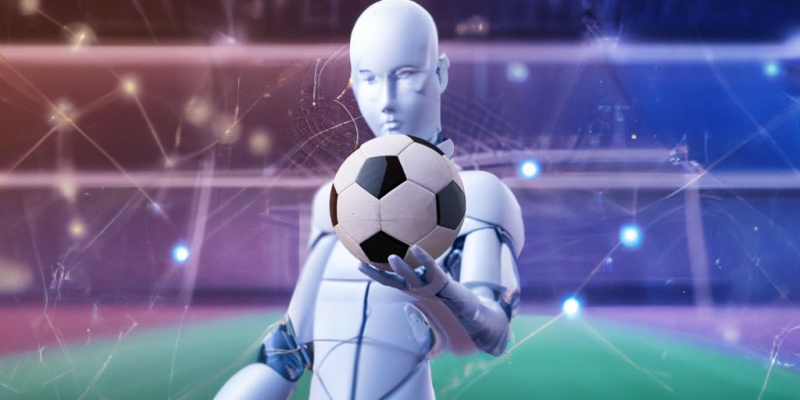For decades, game plans leaned on a coach’s hunch and a bit of chalkboard geometry. Today an assistant might walk in with a heat-map printout, a cloud dashboard, and a model that claims to know how many times the striker must press from the front before fatigue flips the opponent’s full-backs inside. Artificial intelligence is not a crystal ball, yet it chews through footage and GPS logs at speeds no human video room can match. Teams that once hired a single intern to chart touches now employ full data units. Anyone curious how similar-looking algorithms track flanking routes or healing timings in competitive shooters can mine island online game on hubs where analysts cross-compare online-game telemetry with on-field tactics.
Where the Raw Numbers Come From
First, sensors — lots of them. Wearable chips stream acceleration, cameras stitch 3-D player skeletons, and microphone arrays pick up communication patterns. A single match can produce millions of data points, most of them noise until a model spots a repeatable edge. That edge might be as small as a defender shifting weight a frame too early or a basketball shooter gaining two percent accuracy from a particular corner.
Analysts typically bundle their inputs into four buckets:
- Event data — passes, tackles, shots, screen-set angles, tagged by time and location.
- Tracking data — GPS or optical systems sampling position up to thirty times a second.
- Biomechanics — heart-rate variability, jump kinetics, or acceleration peaks.
- Context layers — weather, altitude, travel fatigue, even crowd volume curves.
Once machine-learning models process that pile, they spit out probability maps or risk alerts the coaching staff can actually read before next practice.
AI on the Tactics Board
Pattern-recognition nets have become assistant scouts. In soccer they trace pressing triggers; in baseball they flag pitcher tells; in tennis they highlight where an opponent serves after a long rally 68 percent of the time. Instead of hunting clips manually, a coach types “all high-pressure turnovers in the final third” and gets a playlist in minutes. Deep-learning vision models even track players when camera angles wobble, stitching broadcast feeds into stable datasets.
Helpful outcomes look like this:
- Game-week prep — automated opponent dossiers shorten ten-hour film marathons to four actionable pages.
- In-game nudges — real-time win-probability charts suggest when to swap formations or call a timeout.
- Long-term load management — stress metrics combine with schedule crunch to warn when a star risks muscle tweaks.
- Recruitment filters — scouting models sift thousands of prospects, surfacing fits for a team’s exact style.
The result is not perfect prophecy, but a steady drip of advantages too small to ignore.
Risks and Misreads
Data can seduce. Overfitting on last month’s trend may ignore a star returning from injury or a sudden weather shift. An algorithm trained mostly on highlight plays might undervalue the midfielder who plugs gaps off-camera. And no model knows locker-room mood. Overreliance turns staff meetings into spreadsheet debates, draining gut feel that still matters when chaos hits.
Common pitfalls teams try to dodge:
- Noise masquerading as signal — spurious correlations look solid until reality bites.
- Black-box trust — coaches struggle to argue for a move when the model’s reasoning hides behind layers of math.
- Paralysis by data — too many metrics freeze decision-making at crunch time.
- Ethical landmines — biometric records raise privacy issues when contract talks loom.
Successful outfits use AI for direction, not dictation — letting staff ask questions the machine returns in plain language, then stress-testing those answers with experience.
Esports Foreshadowed the Shift
Competitive gaming, with its complete server logs, offered a laboratory for AI scouting long before traditional sport adopted optical tracking. Teams in popular shooters parse heat maps, crosshair drift, and economy cycles; the jump to on-grass positioning analytics felt natural. Some clubs even hire analysts fresh out of esports because they already treat game states as data events, not gut checklists.
Human Judgment Still Finishes the Play
A model may flag that a winger slips marking duty in minute 72. Someone still decides whether to sub. The best programs blend cold numbers and warm intuition. Coaches revisit tape, ask the player how legs feel, and weigh crowd energy that sensors cannot bottle. When machine and human agree, confidence climbs. When they clash, discussion sharpens.
Looking Downfield
Edge-computer chips soon might stream analytics straight to an assistant’s earpiece without a lagging laptop. Computer-vision updates will follow every limb without the need for wearable tags, cutting broadcast integration time. Federations debate how much real-time data teams can access during play — a coach fed win-prob charts every possession could alter sport rhythms in ways fans and rule-makers are still digesting.
Whatever guardrails emerge, the genie stays out. Film rooms ran on VHS, then laptops; now they pulse with inference engines. Records will keep falling, but credit will go not only to raw talent and relentless drills — it will also nod to the quiet algorithms that spot one more inch of space, one more millisecond of delay, and whisper the tip that makes the difference between almost and champion.

